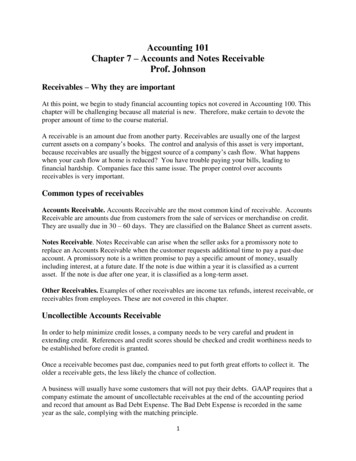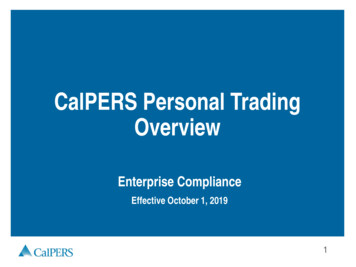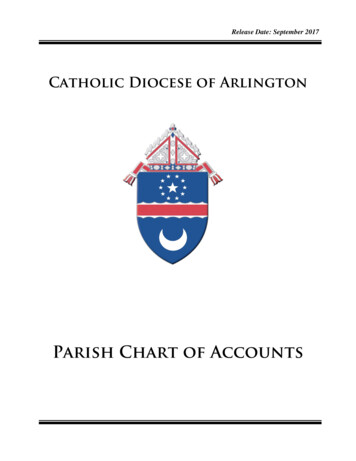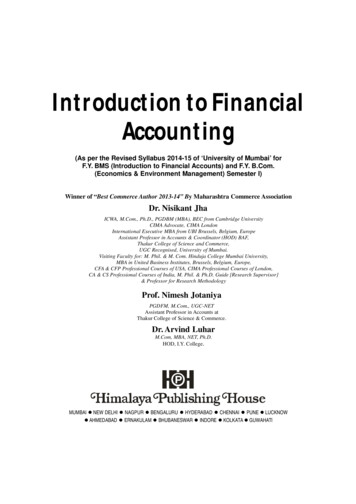
Transcription
Accounting 101Chapter 7 – Accounts and Notes ReceivableProf. JohnsonReceivables – Why they are importantAt this point, we begin to study financial accounting topics not covered in Accounting 100. Thischapter will be challenging because all material is new. Therefore, make certain to devote theproper amount of time to the course material.A receivable is an amount due from another party. Receivables are usually one of the largestcurrent assets on a company’s books. The control and analysis of this asset is very important,because receivables are usually the biggest source of a company’s cash flow. What happenswhen your cash flow at home is reduced? You have trouble paying your bills, leading tofinancial hardship. Companies face this same issue. The proper control over accountsreceivables is very important.Common types of receivablesAccounts Receivable. Accounts Receivable are the most common kind of receivable. AccountsReceivable are amounts due from customers from the sale of services or merchandise on credit.They are usually due in 30 – 60 days. They are classified on the Balance Sheet as current assets.Notes Receivable. Notes Receivable can arise when the seller asks for a promissory note toreplace an Accounts Receivable when the customer requests additional time to pay a past-dueaccount. A promissory note is a written promise to pay a specific amount of money, usuallyincluding interest, at a future date. If the note is due within a year it is classified as a currentasset. If the note is due after one year, it is classified as a long-term asset.Other Receivables. Examples of other receivables are income tax refunds, interest receivable, orreceivables from employees. These are not covered in this chapter.Uncollectible Accounts ReceivableIn order to help minimize credit losses, a company needs to be very careful and prudent inextending credit. References and credit scores should be checked and credit worthiness needs tobe established before credit is granted.Once a receivable becomes past due, companies need to put forth great efforts to collect it. Theolder a receivable gets, the less likely the chance of collection.A business will usually have some customers that will not pay their debts. GAAP requires that acompany estimate the amount of uncollectable receivables at the end of the accounting periodand record that amount as Bad Debt Expense. The Bad Debt Expense is recorded in the sameyear as the sale, complying with the matching principle.1
The Allowance MethodAs previously mentioned, there will always be customers that don’t pay. This could be due to adispute over the amount owed, or due to cash flow problems experienced by the customer. Theamount estimated as uncollectible will be debited to a new operating expense called Bad DebtsExpense. The Bad Debts Expense will be recorded in an adjusting entry that debits Bad DebtsExpense and credits Allowance for Doubtful Accounts. The Allowance for Doubtful Accounts isa contra asset account with a normal credit balance. It will offset the Accounts Receivablebalance. The presentation of Accounts Receivable and the Allowance for Doubtful Accounts onthe balance sheet is often reported as follows.Accounts ReceivableAllowance for Doubtful Accounts100,000(1,000)99,000The 99,000 shown above is called the “realizable value” and estimates what the company canrealistically expect to collect from their account receivables.GAAP mandates that we use the Allowance Method of estimating uncollectible accountsreceivable. (The Direct Write Off method is used by some smaller companies, because it isneeded for tax purposes; it is not acceptable under GAAP.) Most companies estimate theiruncollectible accounts receivable using one of three approaches:1. The percent of sales method2. The percent of receivables method3. The aging of receivables methodThe method chosen will determine the calculation. We will practice these methods ofdetermining the adjustment for bad debts expense extensively in class. These methods aresummarized below.2
1. The percent of sales method. Under this method, the amount of the adjustment iscalculated by multiplying a historical percent of bad debts by the current year’s net creditsales. Although acceptable, this method is not as accurate as the either the percentage ofreceivables method or the aging of receivables method.Example: A company had net sales of 1,000,000. It is estimated that one percent of netsales are uncollectible. The amount of the adjusting entry is 10,000 (1% * 1,000,000).The adjusting entry recorded at the end of the accounting period isBad Debts Expense10,000Allowance for Doubtful Accounts10,0002. The percent of receivables method. The percent of receivables method assumes a givenpercent of a company’s receivables is uncollectible. The desired amount of theAllowance for Doubtful Accounts is calculated by multiplying Accounts Receivable bythis percent. The Allowance for Doubtful Accounts is this adjusted so that it equals thisdesired amount.Example: The balance of Accounts Receivable is 100,000, and it is estimated that 5%of accounts are uncollectible. The balance of the Allowance for Doubtful Accounts,before adjustment, is 2,000 (credit). The desired balance of the Allowance for DoubtfulAccounts would be 5,000 ( 100,000 * 5%). Since the balance of the Allowance forDoubtful Accounts is now only 2,000, a 3,000 adjustment is required, as follows.Bad Debts Expense3,000Allowance for Doubtful Accounts3,0003. The aging of receivables method. Most companies have an aging of customers’accounts receivable. In this aging report, each customer balance is classified by how longit is past due. Based on this aging, experience is used to estimate the percent of eachaging total. Older past due receivables will be more likely uncollectible. Once the totaluncollectible amount is estimated, an adjusting entry is made to increase the Allowancefor Doubtful Accounts so that its balance equals the uncollectible estimate calculated byusing the aging report.Example: Based on its aging report, a company estimates its uncollectible accountsreceivable to be 6,000. The current balance in the Allowance for Doubtful Accounts is 1,000 (credit). An adjusting entry of 5,000 ( 6,000 desired less 1,000 balance beforeadjustment) would be recorded as follows.Bad Debts Expense5,000Allowance for Doubtful Accounts35,000
Writing off a Bad DebtStrict internal control procedures should be used when writing off an account that is no longerdeemed collectible. We will discuss these in class. For example, the entry to write off the 500balance owed by Mahoney Company isAllowance for Doubtful Accounts500Accounts Receivable-Mahoney Company 500Note that Bad Debts Expense is not used to record the write off. This is because Bad DebtsExpense was debited in the adjusting entry to estimate bad debts. If Bad Debts Expense wasdebited in the entry to write off a bad debt, Bad Debts Expense would be counted twice.Collection of a bad debt previously written offIf a company collects an accounts receivable balance previously written off, two entries arerequired. The first entry reverses the write off. The second entry records the cash receipt onaccount. For example, assume Lee Company pays its 350 account previously written off, thefollowing entries would be recorded.Accounts Receivable-Lee Company 350Allowance for Doubtful AccountsCash350350Accounts Receivable-Lee Company350Notes ReceivableNotes Receivable can arise when the seller asks for a promissory note to replace an AccountsReceivable when the customer requests additional time to pay a past-due account. A promissorynote is a written promise to pay a specific amount of money, usually including interest, at afuture date. The journal entries required are: Converting an accounts receivable to a note receivableRecording an adjusting entry for interest receivable at the end of the accounting periodRecording receipt of note payment and interest when dueRecording a dishonored note4
Computing Maturity Date and InterestThe maturity date is the date repayment of the note is due. The interest charged to the issuer ofthe note is a cost of borrowing money for the borrower. We should learn to calculate both.For example, assume a 1,000, 6%, 90-day note was issued on July 15. The maturity date wouldbe October 13, as follows:July (31 days in July minus 15, the date of the note)16August31September30October13Period of the note, in days90To compute interest, multiply the principal of the note by its interest rate and the time factor.For example, the interest due on the note receivable above is 15, calculated as follows: 1,000 * 6% * 90/360 15Recognizing Notes Receivable and Settling Notes ReceivableA seller can accept a note from a customer to grant a time extension on a past-due receivable. Asan example, assume GlobalCom accepted 100 in cash along with a 900, 30-day, 12% notefrom Chef Enterprises on July 5 to settle their 1,000 past-due account. GlobalCom would makethe following entry.July 5Cash100Notes Receivable900Accounts Receivable-Chef Enterprises1,000Assume Chef Enterprises paid the amount due with interest on the due date. GlobalCom wouldrecord the payment asAug. 4Cash909Notes Receivable900Interest Revenue ( 900 * 12% * 30/360)59
If Chef Enterprises did not pay the amount due on August 4, the note would become dishonored.In that case, GlobalCom would have made the following entry:Aug. 4Accounts Receivable-Chef Enterprises909Notes Receivable900Interest Revenue9The Adjusting Entry for Interest ReceivableWhen a note receivable is outstanding at the end of an accounting period, any interest due but notyet received must be recorded. For example, assume a 2,000, 30-day, 6% note receivable wasissued on December 19, 2010. The adjusting entry at December 31 is2010Dec. 31Interest Receivable4Interest Revenue ( 2,000 * 6% * 12/360)4The payment of the note and interest on January 18, 2011 is recorded as follows.2011Jan. 18Cash2,010Notes Receivable2,000Interest Receivable4Interest Revenue ( 2,000*6%*18/360)6Disposing of ReceivablesCompanies sometimes convert receivables to cash before they are due to raise needed cash. Thiscan be accomplished in two ways.(1) Selling (Factoring) Receivables. A company can sell its accounts receivables to a financecompany. The finance company will charge the seller a factoring fee and take ownershipof the receivables. In this case, the finance company assumes the risk of bad debts.(2) Pledging Receivables. A company can also borrow money from a finance company orbank and pledge its receivables as security for the loan. Unlike factoring, this does nottransfer risk of bad debts. If the loan is not paid back the lender can take title to thereceivables pledged. Any pledged receivables must be disclosed in the notes to thefinancial statements.6
(1) Selling (Factoring) Receivables. A company can sell its accounts receivables to a finance company. The finance company will charge the seller a factoring fee and take ownership of the receivables. In this case, the finance company assumes the risk of bad debts. (2) Pledging Receivables. A company can also borrow money from a finance company or











